Within Our Gates: A Counter-History Through A Counter-Cinema
STREET DATE: JULY 26, 2016/KINO LORBER
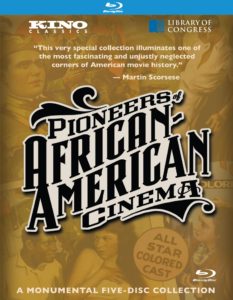 Arriving as a 5-disc series which includes more than 20 features, short films, and documentaries, Kino Lorber’s Pioneers of African-American Cinema is without hyperbole the most significant home video release of the year.
Arriving as a 5-disc series which includes more than 20 features, short films, and documentaries, Kino Lorber’s Pioneers of African-American Cinema is without hyperbole the most significant home video release of the year.
In the years after the February 1915 premiere of The Birth of a Nation, whose racist characterizations of African-Americans and vivid portrayal of white supremacist ideology were embraced by white audiences, the immediate response to this landmark of American cinema by the people it explicitly slandered and vilified was as forceful and persistent as it has been almost entirely ignored. Known from the mid-teens to the mid-40s as “race movies”, or alternately as “sepia pictures” or “black films”, these were independently-made productions that were distributed to and exhibited in exclusively African-American theaters. Featuring an alternate vision of American life and realities, as depicted by African-American producers and directors who would not have been allowed within 50 feet of a Hollywood studio’s gate, these films also gave African-American actors – many of whom may have been widely familiar to popular audiences – the opportunity to essay roles that were not demeaning, servile, or stereotypical.
While many of these films were financed and produced by white-owned companies, their overriding concern, whether as pure entertainment or as message-oriented drama, were to broadly reach African-American audiences who were eager to see their stories and their lives honestly portrayed on the silver screen. For audiences of today, then, the particularly fascinating aspects of watching these antique movies are in seeing a part of American life that was rarely or never depicted in mainstream Hollywood features of the day. As hard-scrabble productions of incredibly limited means, astonishingly inventive figures such as the “great and only” Oscar Micheaux and the multi-talented Spencer Williams arose to take advantage of natural lighting, shot-on-location footage, and their actors’ own personal wardrobes as means to evade the high cost of heavy equipment, elaborate set design, and flashy costumes. Produced on budgets that were the very definition of shoestring, these films in many respects become of greater sociological and historical interest for modern audiences than their more elaborate and technically-superior Hollywood contemporaries.
Finally, there are the stories themselves. 70-90+-years later, what one is struck with in the drama of a provincial town falling under the spell of a hypocritical demagogue or the fall of a good man to the evils of inner city corruption or the tale of a peaceful community erupting in racial violence is just how little the problems facing this country have changed in the interim. Yes, Jim Crow segregation and noose-rope lynchings may be of the past, but their modern forms are as insidious and pervasive. To discover in more exact detail just how relevant these Pioneers of African-American Cinema are to the modern day, then, our contributors have watched and reviewed a selection of films from this important series in order to highlight an alternate history as interpreted by a cinema well outside the mainstream. A counter-history as created by a counter-cinema, these selections offer a rare glimpse of America as seen through the eyes of the oppressed.
– Justin Mory
NOTE: Throughout the article, the images used are present only as a reference to the specific film or its historical context and are not meant to reflect the actual image quality of the Blu-ray or specific content(s) of the extant film. In addition, this article covers only a highlighted selection of films available on Kino Lorber’s “Pioneers of African-American Cinema” and is not meant to represent the total content available on the 5-disc Blu-ray set. The complete list of titles, features, and content available on this essential Blu-ray release is available here.
Mercy the Mummy Mumbled
R.G. Phillips, 1918. 13 minutes. Silent.
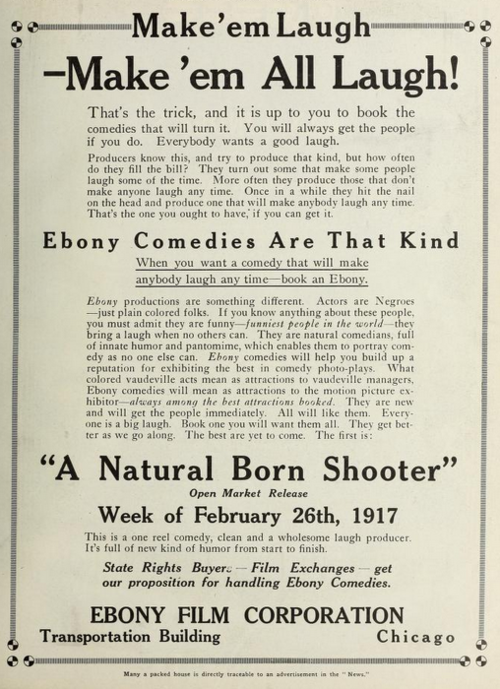
Trade advertisement for “Ebony Film Corporation”, the Chicago-based, white-owned film company that produced comedy shorts like “Mercy the Mummy Mumbled” and “2 Knights of Vaudeville” in the 19-teens.
The things we’ll do for love…or cash. A young man wooing the daughter of a mad scientist answers the scientist’s ad for a “real mummy” to do experiments on – by wrapping a pal in bandages and collecting the dough. While the poor friend endures torture by the scientist with no promise of recompense, a couple of swaggering Egyptian relic hunters come snooping around, adding to the confusion – mostly insofar as their presence at all makes this 13-minute short feel too bloated with unrealized ideas. The shtick with the be-wrapped friend is the only outright funny stuff – also with some possibly latent cash-for-humans commentary – while the rest feels like set-up with middling pay-offs.
– Robert Hornak
2 Knights of Vaudeville
R.G. Phillips, 1918. 10 minutes. Silent.
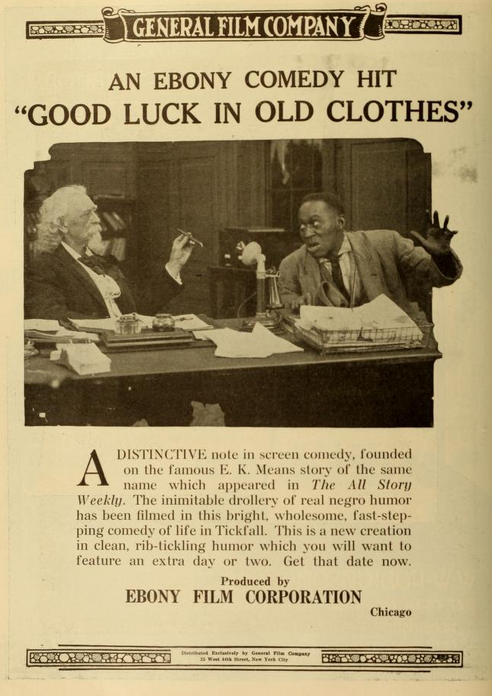
Trade ad for another “Ebony Film Corporation” production. The Chicago-based company folded in the early ’20s but by then had produced hundreds of “race film” shorts.
A story of easy-come-easy-go supplanted by inspiration. Two down-on-their-luck men find tickets to a Vaudeville show, succeed in completely derailing the proceedings, then put on a show of their own back in the neighborhood. It’s like a proto-Apollo Theater experience, as their lack of finesse at flipping, bending, and juggling brings the house down yet again, but not in the good way. The protagonists start on an upswing (finding treasure) but end on a down note (being mocked and ousted by their own patrons), revealing some cultural esteem issues roiling beneath the hijinks.
– Robert Hornak
Within Our Gates
Oscar Micheaux, 1920. 79 minutes. Silent.
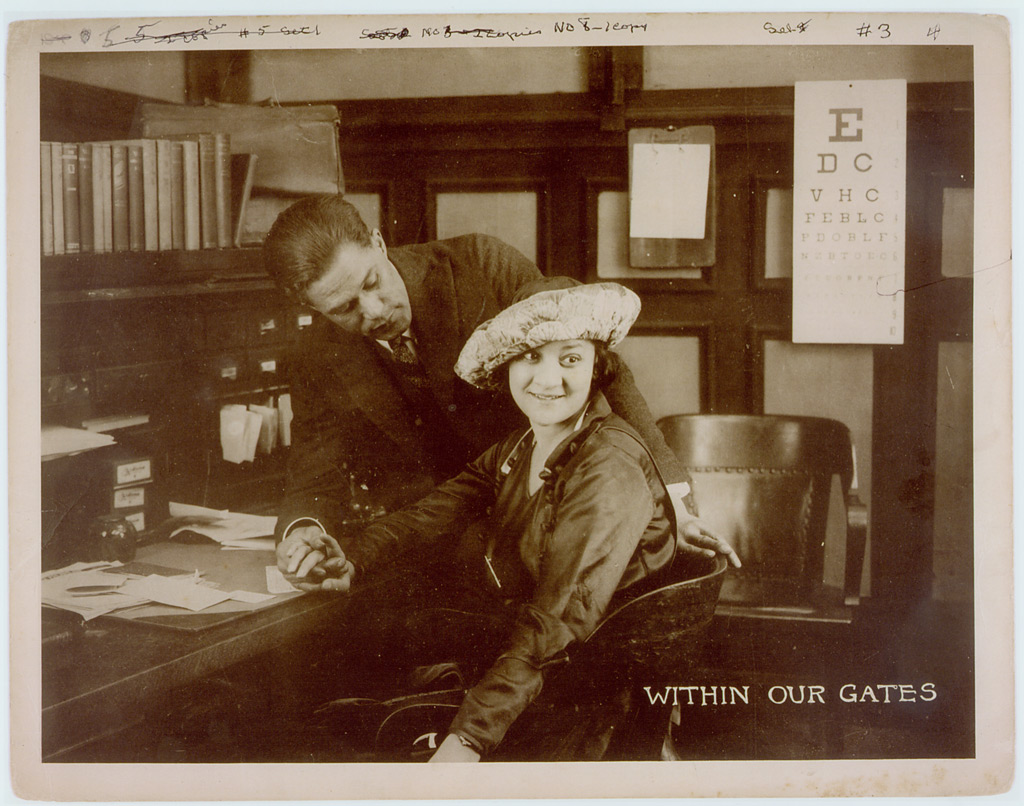
Vintage “lobby card” displaying a production still from Oscar Micheaux’s pioneering “Within Our Gates” (1920).
Within Our Gates is the oldest known extant feature film by an African-American and has been deservedly preserved by the National Film Registry. The film is Micheaux’s open revolt against the overt racism of Griffith’s Birth of a Nation, while still highlighting the sins of deference and complicity within the black community itself. It follows the plight of Sylvia Landry, an African-American woman, as she moves back and forth from a minority-repressing southern town to a larger and more racially-accommodating Boston. Over the course of the deepening melodrama, Sylvia becomes at once a symbol of the new, empowered, free black woman as well as the product and psychological catch-all of the horrors of perpetual white bigotry everywhere. As the sometimes complicated, sometimes just confusing plot elements blend together through some crafty North-South geographical cross-cutting, we slowly become ensnared in Sylvia’s struggle. Rejected by her fiancée who mistakenly thinks she’s been unfaithful while he was away, Sylvia moves back to her home in the south, where she lends her help to a school for black children, which is facing closure soon without a miraculous infusion of cash. She returns northward on a quest for help and finds her miracle: a freak accident with a female philanthropist who donates a sizable amount – while herself battling the white social elites who warn her of wasting her money to help uplift the “inferior” race. While all of this drama is at the fore, we get poignant glimpses into the daily world of African-American lives that would never be seen in a white, Hollywood-financed film of the time. The African-American perspective is requisite to its power: shockingly matter-of-fact images of white mobs lynching innocent black servants run alongside subtler but no less moving moments, such as a black preacher, mocked and struck by whites with a smile on his face, later crumbling into shame and regret over “selling his soul again for a mess of pottage.” There’s an undeniably unfinished quality to this early work of self-taught filmmaker Micheaux, owing some to this being among his first efforts, but mostly due the film’s history of being lost then found in pieces. But the film as we see it today is no less earnest and brutal, and stands as a testament to one man’s strong voice in a climate of overwhelming social oppression.
– Robert Hornak
The Symbol of the Unconquered: A Story of the KKK
Oscar Micheaux, 1920. 59 minutes. Silent.
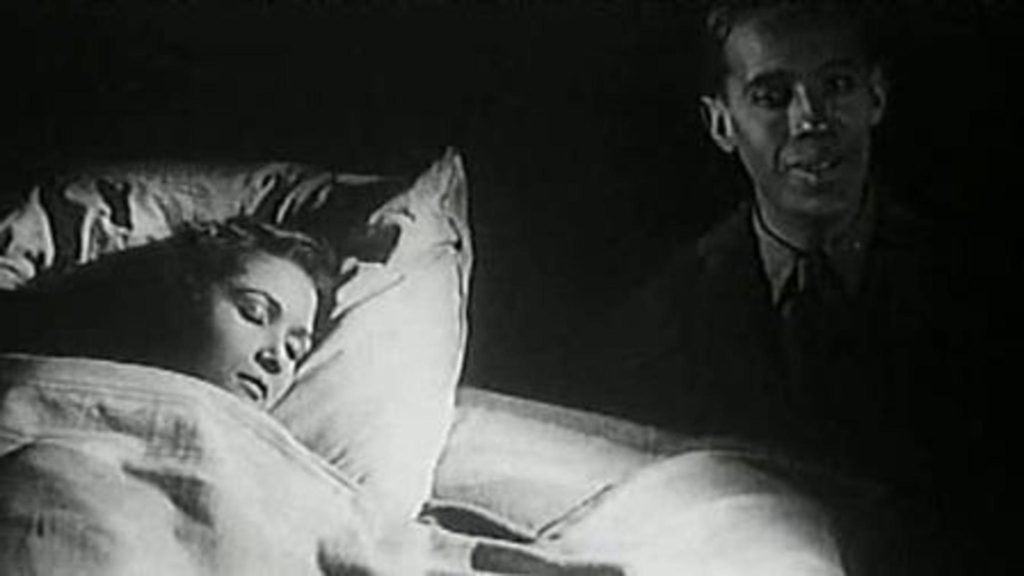
“But if her skin is white, her eyes betray her origins.” That extraordinary intertitle appears early in Oscar Micheaux’s fourth feature, The Symbol of the Unconquered, and refers to a young, light-skinned, mixed race woman named Eve who travels north to the fictional “Oristown” in South Dakota to settle on a claim left to her by her “Negro prospector” grandfather. Refused a room and made to sleep in a barn by a vicious hotel clerk, “a Negro but masquerading as white”, who recognizes the young woman’s “origins” of the intertitle, she is later caught in a storm from which she is rescued by a handsome homesteader, himself of mixed racial origin, named Van Allen… and that’s just where the racial confusion begins. Micheaux apparently had more difficulty distributing this highly-charged, topical melodrama than any of his previous features and what survives today, in a mutilated print discovered in Brussels in the 1990s, possibly only hints at the hard-hitting, unsparing depiction of racial hatred the director originally intended. As it exists, though, the prelude to the ride of the “Black Knights of the Cross” against Van Allen and his claim at the film’s climax seems Micheaux’s direct answer to the similarly climactic Klan Ride, which symbolically subdued an entire race, from D.W. Griffith’s The Birth of a Nation: especially as, in Micheaux’s version, the Riders are “foiled” – as a contemporary review informs us in an intertitle substituting for the missing footage – by a “large colored man armed with a pile of bricks”! Ridiculed and repudiated, the threat is vanquished and the mixed race lovers are free to discover each others’ “true origins”; signaling a happy ending which is as emotionally satisfying as it is vaguely disconcerting.
– Justin Mory
Body and Soul
Oscar Micheaux, 1925. 93 minutes. Silent.
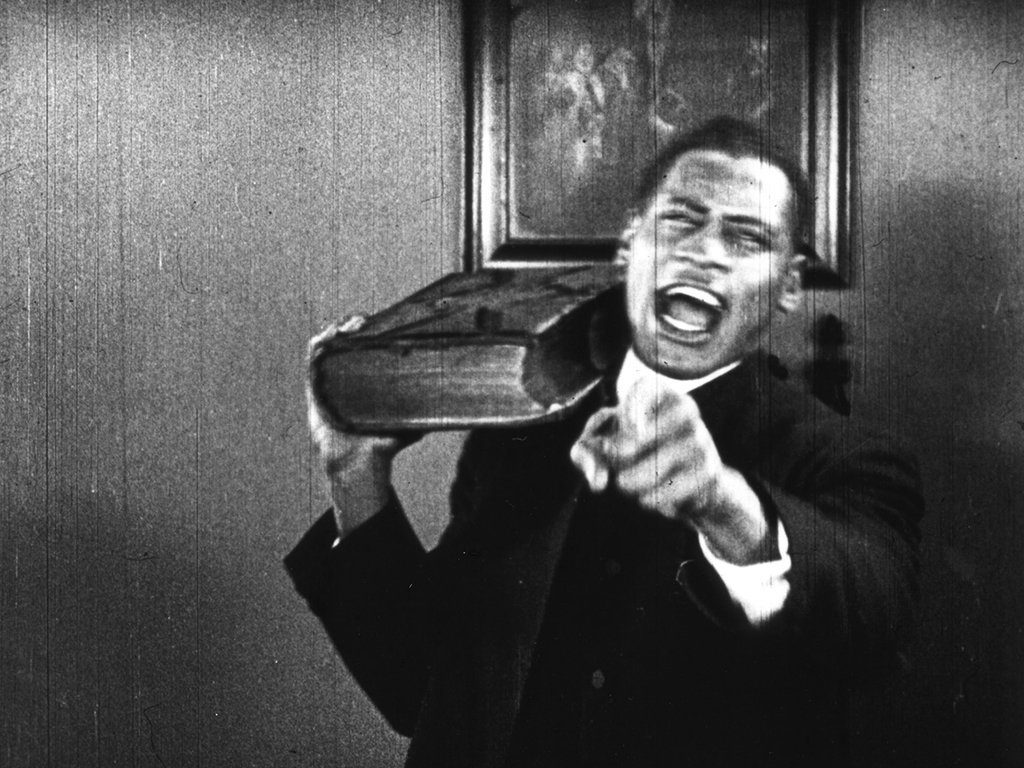
Paul Robeson, the multi-talented singer, actor, and athlete described by film historian Donald Bogle as a “Black Colossus” over mid-twentieth century entertainment, made his motion picture debut in the dual role(s) of false preacher Reverend Isaiah T. Jenkins and his good, industrious brother Sylvester in Oscar Micheaux’s stirring “race” melodrama. As possibly the most recognizable title in this series, Body and Soul fully capitalizes on the overpowering physical presence of Robeson, who imbues the ex-convict masquerading as a minister of the cloth with a leering and threatening quality, while undoubtedly leaving modern-day audiences aching to hear the actor’s resonant bass profondo intone the astonishing “Dry Bones in the Valley” sermon that climaxes this 1925 silent film. While most of the story centers around a mother and daughter drama, which is handled sensitively and realistically, the film gains its bracing tone and jolts of quicksilver unpredictability from the almost schizophrenically indeterminate and divided nature of its male protagonist. A delirious and at times confusing mixture of social commentary and fever-pitched drama, Body and Soul viewed today gains immeasurably from the sincerity of its performances, along with the realistic settings and characterizations that serve to illuminate the symbolic and literal schism existing between this remarkable man’s body and soul.
– Justin Mory
The Flying Ace
Richard E. Norman, 1926. 65 minutes.
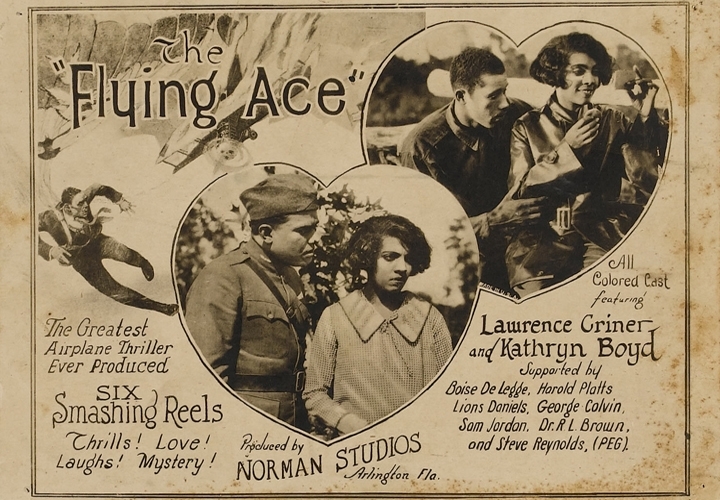
Florida filmmaker Richard E. Norman only made a handful of movies, all in the silent era. His second to last was 1926’s The Flying Ace, an absolutely agreeable caper that may not have broken new ground, but soars in its own crowd-pleasing way. The Flying Ace, in terms of overall production quality, might best be described as altogether competent, on the level of most anything created by in Hollywood ten years earlier, or even at that time. When the titular ace of the title returns to town as a much-decorated war hero, he’s immediately given his old job of railroad detective – for double the pay! Granted, it’s only a temporary offer made in the desperate interest of nabbing whomever made off with the payroll satchel, full of $25,000. Was it the dithering old man who runs the place? Or his eyelash-batting grown daughter? Or what about the overly ambitious security guard? Or any number of other semi-likely suspects? Partly a drawing room whodunnit (albeit set in the dusty old South), partly a race-against-the-clock caper, The Flying Ace demonstrates that one needn’t have been working in Hollywood to have grasped a solid control of cinematic form. And if that isn’t enough, watch this film if you want to see how a one legged man rides a bicycle at high speed while firing a rifle! There may not be all that much flying in The Flying Ace, but the film nonetheless does take flight in its own entertaining number of ways.
– Jim Tudor
Ten Nights in a Bar Room
CPFC, 1926. 64 Minutes. Silent.
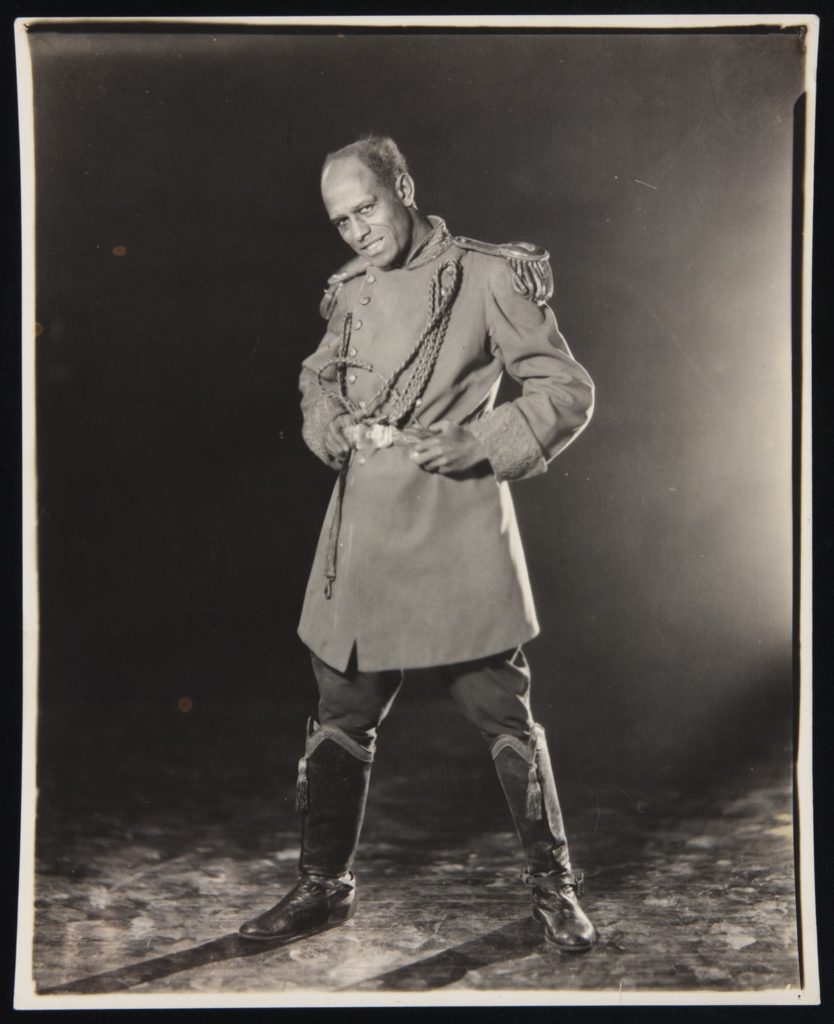
Legendary stage actor Charles Gilpin, who originated the role of Eugene O’Neill’s “Emperor Jones” (1920) on Broadway and passed away in 1930, having by then appeared in only a handful of films.
Featuring one of the few known film performances of legendary stage actor Charles Gilpin, who had originated the title role in Eugene O’Neill’s groundbreaking 1920 play Emperor Jones and who would later star in 1929’s The Scar of Shame, Ten Nights in a Bar Room concerns the small Southern town of Cedarville and its corruption by a local speakeasy and gambling den. Gilpin plays Joe Morgan, who sells the town’s gin mill to the nefarious Simon Slade (Lawrence Chenault) and quickly descends into alcoholism, resulting in tragedy both for the town and his family. Essentially a late addition to the “temperance film” popular in the early portion of the Prohibition era, the obvious nature of both the message and drama benefits from its frank portrayal of the effects of poverty and vice on a specifically African-American community. With its emphasis on social problems that mainstream Hollywood would not have dreamed of dealing with at the time, the film is at least 40 years ahead of its time; resulting in a quite remarkable apotheosis of community violence, directed squarely against the town’s source of evil, that in fact prefigures the climax to Spike Lee’s Do The Right Thing (1989) by a full 63 years!
– Justin Mory
Eleven P.M.
Richard Maurice, 1928. 60 minutes. Silent.
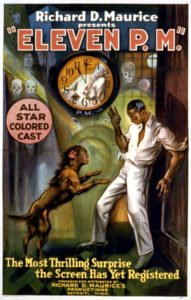 Like the Micheaux films of the period, writer/director Richard Maurice offers a somewhat dizzying hodgepodge of melodrama and social commentary that is as undeniably powerful as it is potentially confusing. In a complex, highly-wrought narrative encompassing multiple characters, decades of conflict, and even animal-spirit mysticism(!), the film is framed, and literally dreamed up, by a young African-American newspaper writer (Sammie Fields) who is on the tight deadline of the title! The dramatis personae of the young writer’s dreamed drama of strife in the inner city include the beleaguered “mixed race” street performer Sundaisy (writer/director Maurice), his estranged wife (Orine Johnson), their talented daughter (played by Johnson as an adult), and the unrepentant street hood Clyde (uncredited) of whom Sundaisy promised the boy’s dying father Stewart (H. Marion Williams) to help reform. Ending in tragedy for all concerned, the film features an early depiction of the cycle of poverty, criminality, and revenge later shown in social dramas of the 1930s couched, somewhat, by the supernatural aspects of the story, not to mention the framing device of a dream-vision. For its contemporary audience, though, the strange goings-on possibly helped justify the film’s frank portrayal of bleak social ills.
Like the Micheaux films of the period, writer/director Richard Maurice offers a somewhat dizzying hodgepodge of melodrama and social commentary that is as undeniably powerful as it is potentially confusing. In a complex, highly-wrought narrative encompassing multiple characters, decades of conflict, and even animal-spirit mysticism(!), the film is framed, and literally dreamed up, by a young African-American newspaper writer (Sammie Fields) who is on the tight deadline of the title! The dramatis personae of the young writer’s dreamed drama of strife in the inner city include the beleaguered “mixed race” street performer Sundaisy (writer/director Maurice), his estranged wife (Orine Johnson), their talented daughter (played by Johnson as an adult), and the unrepentant street hood Clyde (uncredited) of whom Sundaisy promised the boy’s dying father Stewart (H. Marion Williams) to help reform. Ending in tragedy for all concerned, the film features an early depiction of the cycle of poverty, criminality, and revenge later shown in social dramas of the 1930s couched, somewhat, by the supernatural aspects of the story, not to mention the framing device of a dream-vision. For its contemporary audience, though, the strange goings-on possibly helped justify the film’s frank portrayal of bleak social ills.
– Justin Mory
Hell-Bound Train
James and Eloyce Gist, 1930. 50 minutes. Silent.
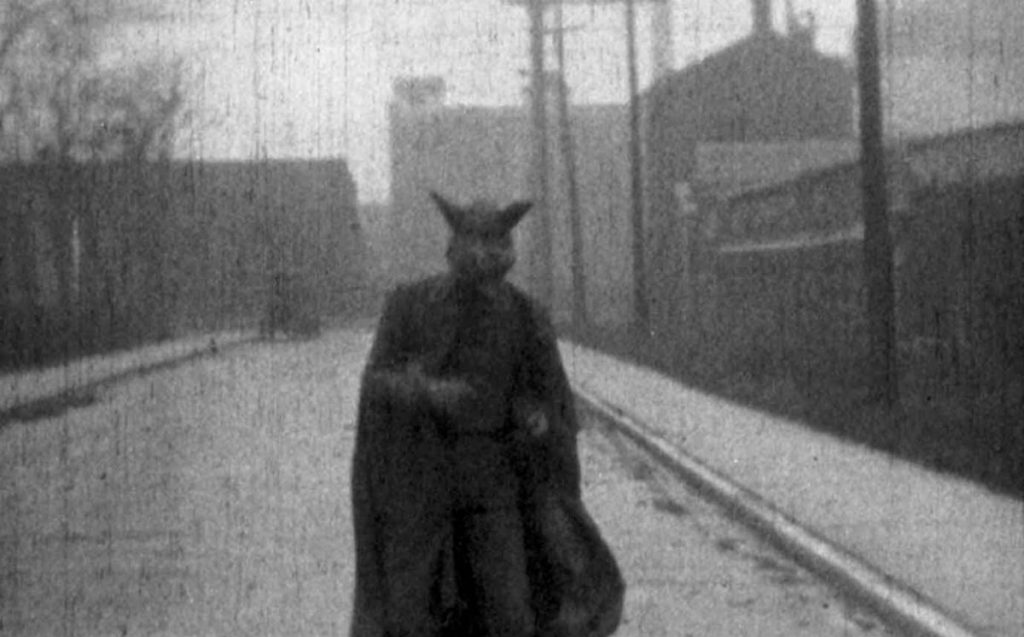
The Gists were traveling ministers who made films to accompany their fire-and-brimstone message. They taught themselves filmmaking – this was their first – and while it’s laden with the mistakes anyone would make their first time working with the raw materials of a complicated process, there’s yet vibrancy to the product that can only be credited to their religious zeal. The movie is constructed as a series of vignettes that reflect the many ways a person can fall into the clutches of the Devil, with an emphasis on the permanent nature of the deals one strikes with him for personal pleasure or gain. Like a kind of Dante’s Inferno on rails, each coach on this train to hell is reserved for a different brand of sin, and we get glimpses into each: the dancing coach features moments of alcohol abuse, the implication of loose sex, an explosion of gunplay, and the swiftness of impulsive murder; the second coach, as if to hammer it home, features drunkenness again, along with poverty, robbery, and mistreatment of women and girls; the third is reserved for jazz music, which “destroys the minds of little children.” And so on. A great effort seems to have been made to include every possible sin over the film’s 50 minutes, lest the makers be held liable for your eternal damnation: not to be forgotten, there’s thieving, grafting, lying, cheating, playing pool, bootlegging, impudence toward parents, “boys who mistreat dumb animals”, and the final, catch-all coach, “Immorality”. The Devil himself is featured frequently, his iconic horns and claws on display, his bifurcated tail sailing through the air as he does a jig over every new recruit that boards his train of evil. “How my heart does rejoice!” reads the title card with each new conquest across this massive flipbook of transgressions. There’s no denying the earnest intent behind the film, even as the message is blunted by what must have been, even then, a series of on-the-nose messages, meted out with labored acting and a great deal of redundancy.
– Robert Hornak
The Exile
Oscar Micheaux, 1931. 78 minutes
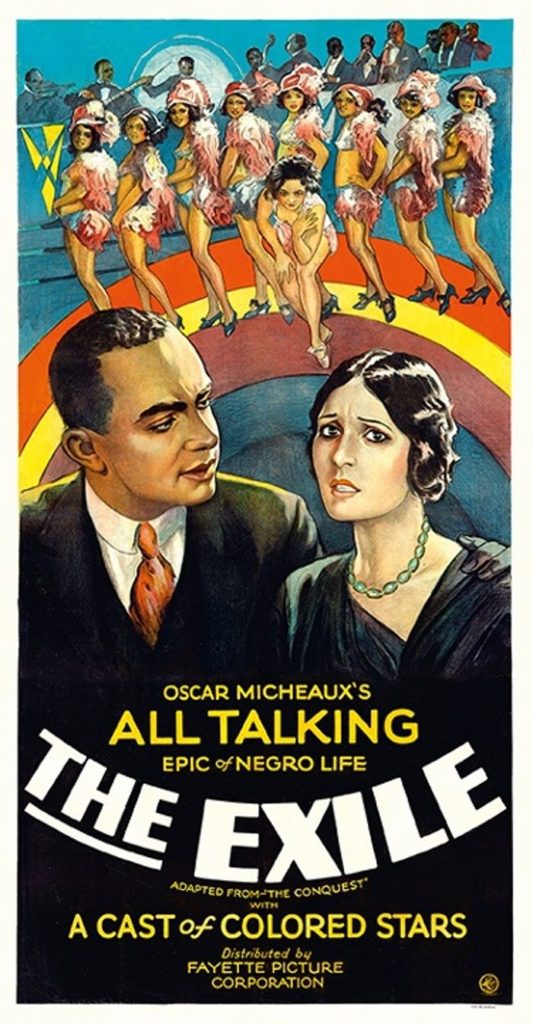
An often leaden melodrama heavily slowed by inert filmmaking. But one must sweep away any justified reactions to the stilted acting and camera work and focus on its place in history – The Exile is the first sound feature made by an African-American (Micheaux) and a remake of his own silent film, which was itself the first feature made at all by an African-American. The film fits well inside Micheaux’s typical form of rangy melodrama – this time, perhaps literally, as it finds its protagonist, Jean Baptiste, fleeing the carnal heart of Chicago for the wide open ranges of a ranch in South Dakota. Here the film’s author includes a piece of his own biography, having been a cattleman in South Dakota – an experience previously incorporated into his novel and an earlier film, both titled The Homesteader – and makes himself the hero. The film is framed by de facto black self-reliance, ignoring a culture that was willfully, violently suppressing black progress. Still, like other Micheaux films, The Exile does not shy away from depicting disrepair amongst the black population – it is as bold in its depiction of blacks murdering other blacks as it is unafraid of showing an empowered upper class of African-Americans partaking freely of the opportunities innate to our country. Also, it’s fascinating to imagine how audiences must have reacted to what must be among the first depictions of interracial kissing. The film’s quality, as a whole, makes it difficult to not at least partially condemn, but its import as an envelope-pushing milestone of African-American creative agency makes it an indispensable cultural artifact.
– Robert Hornak
Darktown Revue
Oscar Micheaux, 1931. 18 minutes.
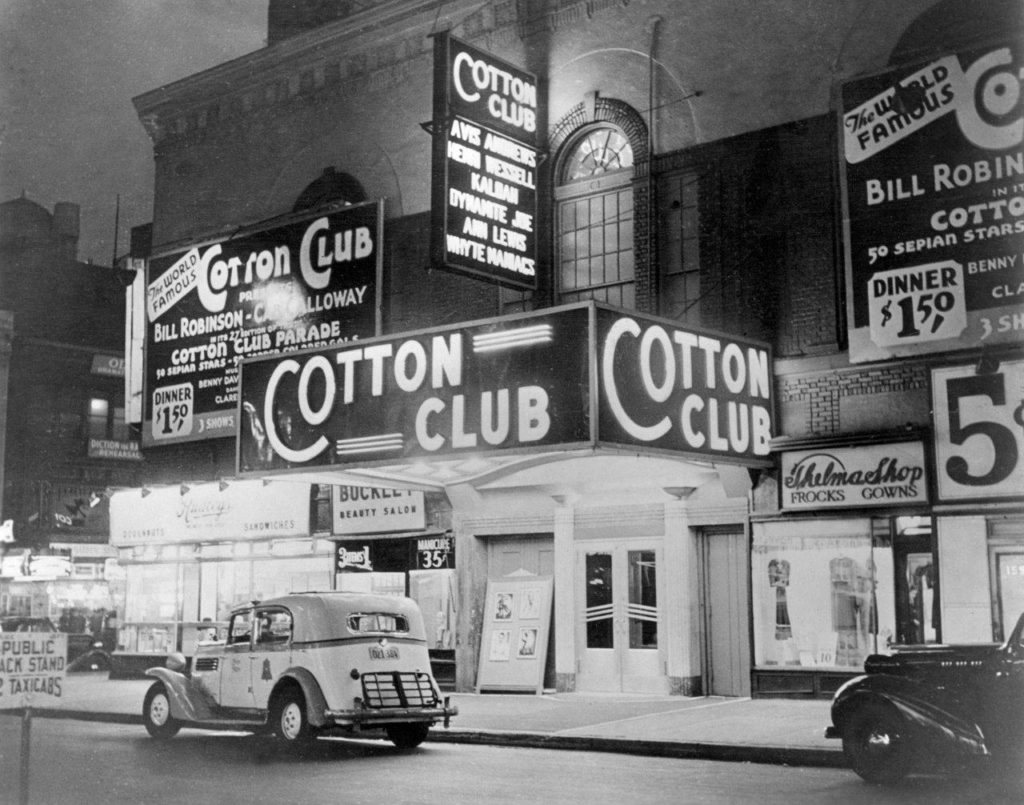
Vintage nightlife scene from the Harlem Renaissance.
Micheaux’s two-reel performance film, featuring three Harlem-based musical and comedy acts, was originally designed as a prologue to be screened with his first sound feature, The Exile (1931). Essentially made up of all the nightclub and vaudeville material Micheaux didn’t use in the former film – including seven astonishing (and astonishingly varied) songs performed by Donald Heywood’s Harlem Choir, the subtly satirical stylings of the (deceptively) “simple” comic duo Andrew Tribble and Tim Moore, and, finally, the (brilliant and bizarre) African-American blackface monologist Amon Davis – Darktown Revue quite simply evokes the period of the Harlem Renaissance better than any film in existence.
– Justin Mory
Veiled Aristocrats
Oscar Micheaux, 1932. 48 minutes.
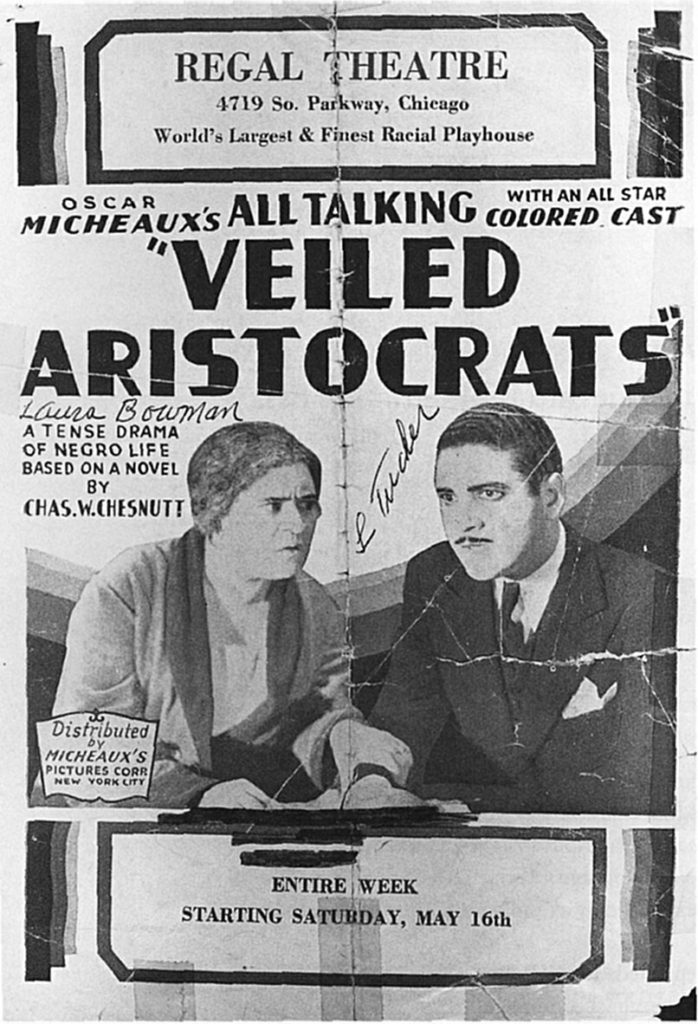
Rare movie poster advertising the sort of “limited run” distribution model followed by independent “race film” producers like Oscar Micheaux, this one advertising a Chicago theater showing of his 1932 production of “Veiled Aristocrats”. (In addition, this poster was apparently signed by two of its stars, Lorenzo Tucker and Laura Bowman).
Micheaux’s second sound feature, like his first sound feature The Exile (1931), was a remake of an earlier silent picture, in this case 1925’s The House Beyond the Cedars. Existing today solely in a foreshortened version (like many Micheaux productions, the victim of local censorship boards), this “passing” drama concerns one John Walden (Lorenzo Tucker), a light-skinned northern lawyer who returns to his southern hometown to offer his similarly light-skinned sister Rena (Lucille Lewis) an opportunity to better herself by posing as the ward of his benefactor Judge Straight (Lawrence Chenault), thus in effect joining the white community. Rena soon attracts the interests of a white suitor (Barrington Guy) but is torn between the advantages of her new life and her love for childhood friend Frank Fowler (Carl Mahon), a dark-skinned local businessman. The choice between two, fundamentally separate worlds is clear in this heartfelt drama but, like The Exile before it, one wishes to see the earlier, now lost silent feature upon which it is based, if only to compare how the endlessly talky scenes and unimaginative camera set-ups were handled in the original silent drama. As such, as with all Micheaux sound features, the incongruous inclusion of varied musical acts – in this case, the maid, cook, and chauffeur improbably celebrating Rena’s ultimate choice of the black suitor with a five minute scat singing and tap dancing sequence – actually does much to liven up the leaden proceedings a bit!
– Justin Mory
Ten Minutes to Live
Oscar Micheaux, 1932. 58 minutes.
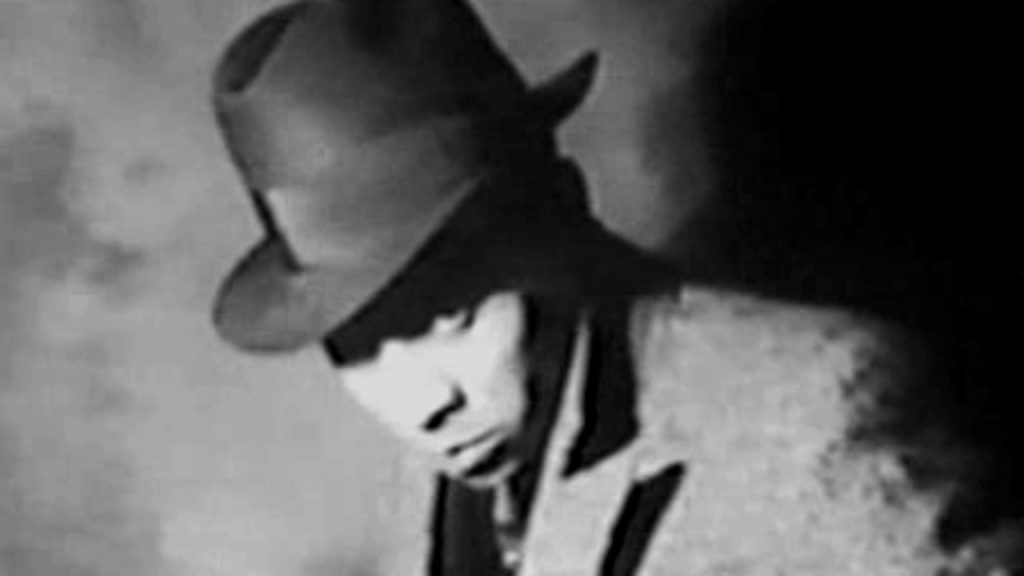
The conversion to sound pictures, with 1931’s The Exile, was not an easy one for director Micheaux, but the director’s motto of Got to keep going!, recorded by biographer Patrick McGilligan, is undoubtedly evident in this Harlem-set sound production of 1932. Based on three (unpublished) short stories by the director, the various strands of this anthology film of “Harlem Life” – including a “renowned” director’s attempt to “recruit” a female performer, the (attempted) violent revenge of a spurned woman tricked into a sham marriage, and a concluding melodrama involving an ill-starred romance between a young woman and an escaped convict – come together at the fictional “Club Lybia”, where dancers, musical performers, and vaudeville acts from the real-life Cotton Club and Connie’s Inn are recorded for all posterity. Yes, a discerning viewer may object to the stagy blocking, the overwritten dialogue, the charitably “amateur” performances, and, most glaringly, the director’s once-audible cry of “Cut!”, but what these independent, hard-scrabble productions lack in resources and technical proficiency they more than make up for in portraying a side of American life almost entirely ignored by mainstream Hollywood.
– Justin Mory
The Girl from Chicago
Oscar Micheaux, 1932. 70 minutes.
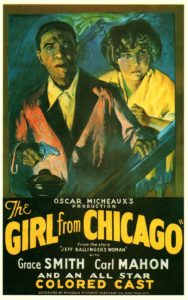 Based on his 1926 silent film The Spider’s Web (now lost), Micheaux updated the social message excoriating vice and worker exploitation of the original to include fast-talking gangsters, sexy nightclub entertainers, and a romantic detective. (So, yes, like contemporary social docudramas of the day produced in Hollywood, Micheaux’s more independent-minded production partially ends up glorifying the evils it is supposedly condemning.) Undercover “Secret Service” agent Alonzo White (Carl Mahon) is dispatched to the sleepy Southern burg of “Batesburg” where he romances a pretty young schoolteacher named Norma Shepard (Starr Calloway) and runs afoul of corrupt plantation owner Jeff Ballinger (John Everett), who cheats his workers with unfair (and unlawful) business practices. After arresting the scoundrel, the action somehow switches north to Harlem (possibly to take advantage of more exotic city nightlife footage) as Ballinger’s abused girlfriend Liza (Grace Smith) flees her tragic past to an even more tragic future when she becomes a nightclub chanteuse at the gangster-owned “Radium Club”. As the chief gangster, the great Afro-Puerto Rican actor Juano Hernandez has a brief though menacing appearance, pre-dating his commanding Hollywood debut in 1949’s Intruder in the Dust by 17 years, but beyond this bit of brilliant casting The Girl from Chicago‘s confused (and confusing) array of melodrama, detective movie, musical, and social message, while fun in parts, unfortunately shows the limits of its budget and the increasingly slapdash nature of Micheaux’s films of the period.
Based on his 1926 silent film The Spider’s Web (now lost), Micheaux updated the social message excoriating vice and worker exploitation of the original to include fast-talking gangsters, sexy nightclub entertainers, and a romantic detective. (So, yes, like contemporary social docudramas of the day produced in Hollywood, Micheaux’s more independent-minded production partially ends up glorifying the evils it is supposedly condemning.) Undercover “Secret Service” agent Alonzo White (Carl Mahon) is dispatched to the sleepy Southern burg of “Batesburg” where he romances a pretty young schoolteacher named Norma Shepard (Starr Calloway) and runs afoul of corrupt plantation owner Jeff Ballinger (John Everett), who cheats his workers with unfair (and unlawful) business practices. After arresting the scoundrel, the action somehow switches north to Harlem (possibly to take advantage of more exotic city nightlife footage) as Ballinger’s abused girlfriend Liza (Grace Smith) flees her tragic past to an even more tragic future when she becomes a nightclub chanteuse at the gangster-owned “Radium Club”. As the chief gangster, the great Afro-Puerto Rican actor Juano Hernandez has a brief though menacing appearance, pre-dating his commanding Hollywood debut in 1949’s Intruder in the Dust by 17 years, but beyond this bit of brilliant casting The Girl from Chicago‘s confused (and confusing) array of melodrama, detective movie, musical, and social message, while fun in parts, unfortunately shows the limits of its budget and the increasingly slapdash nature of Micheaux’s films of the period.
– Justin Mory
Birthright
Oscar Micheaux, 1938. 73 minutes.
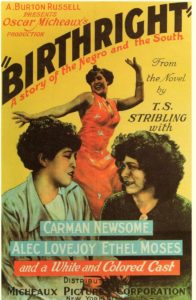 Another remake of another now-lost silent film (in this case, 1924’s same-titled Birthright), the later version of this drama exposing the “rank corruption of the South” ends up being one of Micheaux’s better sound features. “Opening up” the drama with plenty of outdoor, on location-shot footage, Birthright also has the advantage of likable performers in the lead roles and plenty of suspense as the drama builds to its exciting climax. Though the first two reels of this 1938 production are missing in the current restoration, the viewer is plunged right in to the drama of returning Ivy League graduate Peter Siner (Carman Newsome), who is immediately swindled out of some land due to the unscrupulous business practices of the Jim Crow-era South. Soon caught in a three-cornered romance between his best friend, the returning war veteran Tump Pack (Alex Lovejoy), and the sensuous nightclub performer Cissie Dildine (Micheaux-favorite Ethel Moses), Siner is offered the position of personal secretary to elderly plenipotentiary Captain Renfew (George E. Lessey) after the death of his mother (Trixie Smith). Though much is left unstated and implied in the drama of self-sacrifice, jealousy, and budding violence that follows, Micheaux, as in his best early silent films, offers a panoramic view of a corrupt community and the roots of evil that perpetuate the sins of the past.
Another remake of another now-lost silent film (in this case, 1924’s same-titled Birthright), the later version of this drama exposing the “rank corruption of the South” ends up being one of Micheaux’s better sound features. “Opening up” the drama with plenty of outdoor, on location-shot footage, Birthright also has the advantage of likable performers in the lead roles and plenty of suspense as the drama builds to its exciting climax. Though the first two reels of this 1938 production are missing in the current restoration, the viewer is plunged right in to the drama of returning Ivy League graduate Peter Siner (Carman Newsome), who is immediately swindled out of some land due to the unscrupulous business practices of the Jim Crow-era South. Soon caught in a three-cornered romance between his best friend, the returning war veteran Tump Pack (Alex Lovejoy), and the sensuous nightclub performer Cissie Dildine (Micheaux-favorite Ethel Moses), Siner is offered the position of personal secretary to elderly plenipotentiary Captain Renfew (George E. Lessey) after the death of his mother (Trixie Smith). Though much is left unstated and implied in the drama of self-sacrifice, jealousy, and budding violence that follows, Micheaux, as in his best early silent films, offers a panoramic view of a corrupt community and the roots of evil that perpetuate the sins of the past.
– Justin Mory
The Bronze Buckaroo
Richard C. Kahn, 1938. 58 minutes.
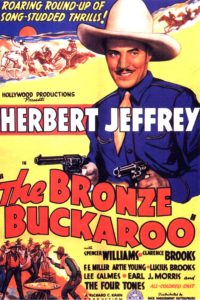 “I love to hit the leather/in any sort of weather/and I know I’ll never change,” sing The Four Tones over the opening credits. Far from the socially-conscious “race” films of Oscar Micheaux and others, and almost delighting in its own freedom from such heavy-handedness, The Bronze Buckaroo can stand alongside most any other B-western of its time. Forget that John Ford, with 20 years of mastering his craft behind him, was about to shoot Stagecoach, a rich collection of character studies and one of the all-time classics of the genre, The Bronze Buckaroo – its name alone sealing its fate – fits squarely among the “lesser” westerns of the era, with its threadbare story, its thin dialogue, and its sometimes remarkably bad performances. The story, simple as it is, follows Bob and his pals going to friend Joe’s ranch to respond to a written distress signal, only to discover his lovely sister there alone, saying Joe’s nowhere to be found, and Bob vowing to find him. Along the way, a small running gag about a possibly talking mule effectively blossoms into its own subplot, one that helps as much to frame the movie as a comedy as a standard western shoot-’em-up. That sly mix of laughs makes all the low-budget trappings slip into meaninglessness as the actors cavort about the expected clichés. Yet as the film indulges in all the set-pieces of any typical period western: bar fight, horse chase, wilderness gunfight, campfire song, and damsel in denim distress, it does so without any actual allusion to race, and so succeeds in creating a quietly defiant tone, an unforced spirit of equal achievement that never feels like the explicit message. Ultimately, the fun of watching this movie is in the very fact of its casting, a fact that the movie itself seems happy to neglect as a point of interest.
“I love to hit the leather/in any sort of weather/and I know I’ll never change,” sing The Four Tones over the opening credits. Far from the socially-conscious “race” films of Oscar Micheaux and others, and almost delighting in its own freedom from such heavy-handedness, The Bronze Buckaroo can stand alongside most any other B-western of its time. Forget that John Ford, with 20 years of mastering his craft behind him, was about to shoot Stagecoach, a rich collection of character studies and one of the all-time classics of the genre, The Bronze Buckaroo – its name alone sealing its fate – fits squarely among the “lesser” westerns of the era, with its threadbare story, its thin dialogue, and its sometimes remarkably bad performances. The story, simple as it is, follows Bob and his pals going to friend Joe’s ranch to respond to a written distress signal, only to discover his lovely sister there alone, saying Joe’s nowhere to be found, and Bob vowing to find him. Along the way, a small running gag about a possibly talking mule effectively blossoms into its own subplot, one that helps as much to frame the movie as a comedy as a standard western shoot-’em-up. That sly mix of laughs makes all the low-budget trappings slip into meaninglessness as the actors cavort about the expected clichés. Yet as the film indulges in all the set-pieces of any typical period western: bar fight, horse chase, wilderness gunfight, campfire song, and damsel in denim distress, it does so without any actual allusion to race, and so succeeds in creating a quietly defiant tone, an unforced spirit of equal achievement that never feels like the explicit message. Ultimately, the fun of watching this movie is in the very fact of its casting, a fact that the movie itself seems happy to neglect as a point of interest.
– Robert Hornak
The Blood of Jesus
Spencer Williams, 1941. 57 minutes.
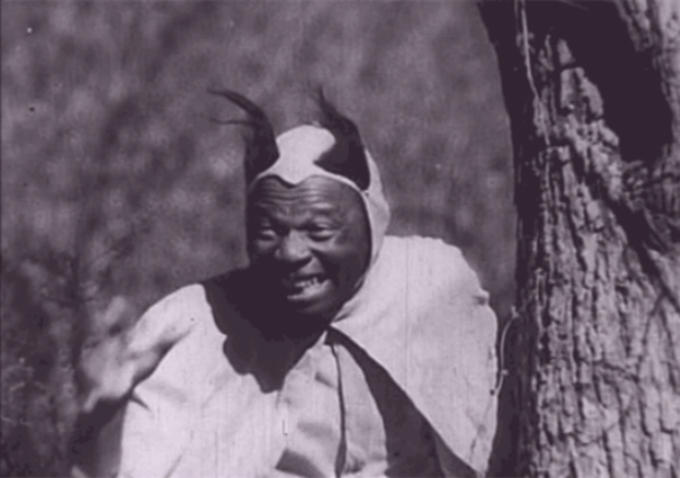
Although it might take some doing to arrive at this conclusion, Spencer Williams’ (before he would become Andy of Amos and Andy) 1941 religious drama/musical is in fact more than a homemade string of spiritually charged vignettes set to old time negro spirituals. The film, despite it’s many, many rough edges, has been hailed as a haunting masterwork by bigger names and outlets: J. Hoberman declared is “A masterpiece of folk cinema that has scarcely lost its power to astonish.” Time says it’s one of the 25 most important films on race. As recently as this month, Ashley Clark of Film Comment called it a “most remarkable… woozy religious fable.” In contract, there is my own initial experience. Upon first viewing, this critic and seasoned student of film history, no less!, found it to be a downright amateur effort in nearly every way. A masterpiece?? “Most remarkable”??? The question entered my mind: To what end is a “pass” being given to this Christian morality tract, this “faith based film” of it’s time and place…? Hold that thought. Time and place – and resources – must not be overlooked when it comes to these vintage “race films”. A squinted, yet sharper second look reveals The Blood of Jesus to be a hazy cacophony of oddly exposed film imagery and popping audio. There’s temptation at a literal crossroads, devils in devil suits, seedy dance clubs, and crucifixes with disembodied scripture-spouting voices. The film O Brother, Where Art Thou? might be playing out, just around the corner! All of it held together with the dusty, withering editing tape and good faith of the filmmakers and their amateur stable of talent. The Blood of Jesus is a fever dream of a sermon, and of special interest to fans of vintage African-American music.
– Jim Tudor
Dirty Gertie from Harlem U.S.A.
Spencer Williams, 1946. 60 minutes.
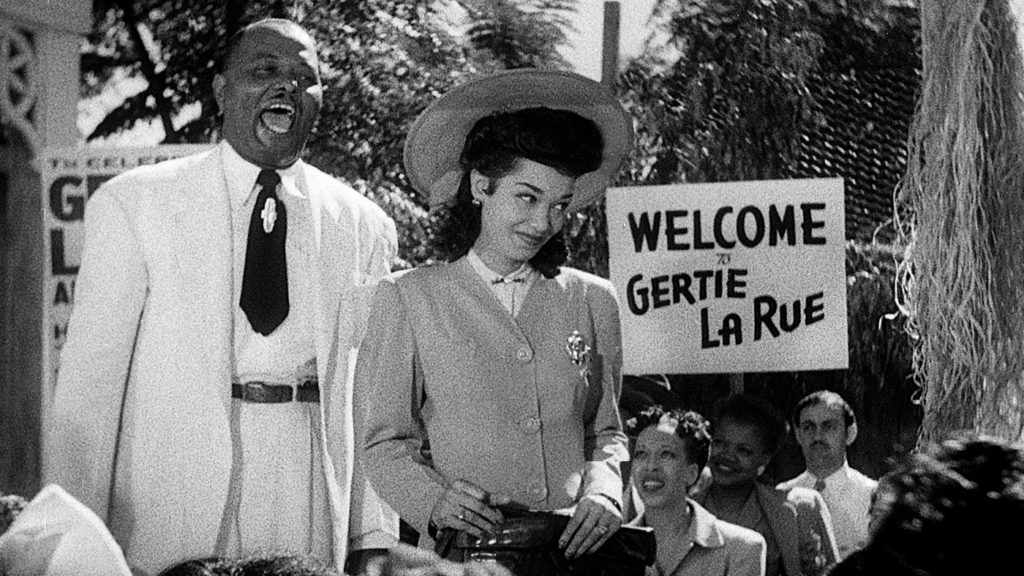
As the other remarkable figure in “race films”, Spencer Williams was both an entertainer who enjoyed great success over several decades and a serious message filmmaker who attempted to honestly portray social issues facing African-Americans of the day. The provocatively-titled Dirty Gertie from Harlem U.S.A. finds Williams enacting/indulging his roles as an entertainer and message-maker in this melodrama of bad girl Harlem performer Gertie LaRue (Francine Everett) who arrives on the fictional Caribbean island of “Rinidad” to play fast-and-loose with the affections of a long procession of (in some cases, visibly) salivating men. Before long, Dirty Gertie’s wild ways catch up with her and soon finds her salacious stage act the target of two crusading Back to Africa missionaries and, eventually, herself the target of a discarded former lover hellbent on violent revenge. With its frank depiction of sensuality, sexual jealousy, and especially the hypocritical zeal of the two missionary figures – in one astonishing sequence the appropriately-named Mr. Christian (Alfred Hawkins) brands Gertie a “painted trollop” while thirstily drinking in her curvaceous form – Dirty Gertie defiantly distinguishes herself from the sexless servants and personality-less entertainer roles an actress like Francine Everett might have found herself playing in Hollywood films at the time.
– Justin Mory

